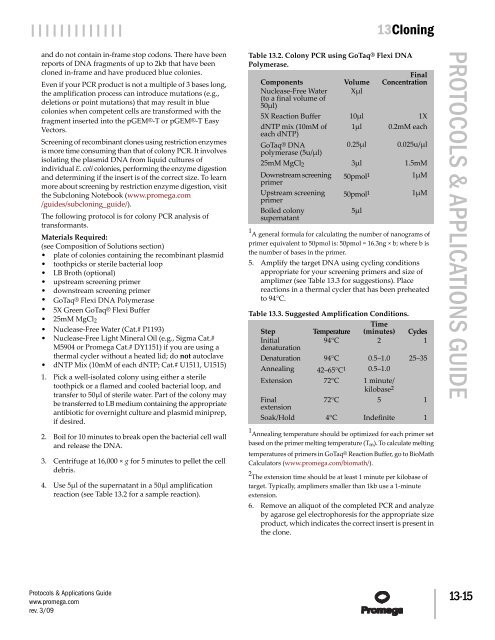Protocols and Applications Guide (US Letter Size) - Promega
Protocols and Applications Guide (US Letter Size) - Promega
Protocols and Applications Guide (US Letter Size) - Promega
Create successful ePaper yourself
Turn your PDF publications into a flip-book with our unique Google optimized e-Paper software.
||||||||||||| 13Cloning<br />
<strong>and</strong> do not contain in-frame stop codons. There have been<br />
reports of DNA fragments of up to 2kb that have been<br />
cloned in-frame <strong>and</strong> have produced blue colonies.<br />
Even if your PCR product is not a multiple of 3 bases long,<br />
the amplification process can introduce mutations (e.g.,<br />
deletions or point mutations) that may result in blue<br />
colonies when competent cells are transformed with the<br />
fragment inserted into the pGEM®-T or pGEM®-T Easy<br />
Vectors.<br />
Screening of recombinant clones using restriction enzymes<br />
is more time consuming than that of colony PCR. It involves<br />
isolating the plasmid DNA from liquid cultures of<br />
individual E. coli colonies, performing the enzyme digestion<br />
<strong>and</strong> determining if the insert is of the correct size. To learn<br />
more about screening by restriction enzyme digestion, visit<br />
the Subcloning Notebook (www.promega.com<br />
/guides/subcloning_guide/).<br />
The following protocol is for colony PCR analysis of<br />
transformants.<br />
Materials Required:<br />
(see Composition of Solutions section)<br />
• plate of colonies containing the recombinant plasmid<br />
• toothpicks or sterile bacterial loop<br />
• LB Broth (optional)<br />
• upstream screening primer<br />
• downstream screening primer<br />
• GoTaq® Flexi DNA Polymerase<br />
• 5X Green GoTaq® Flexi Buffer<br />
• 25mM MgCl2<br />
• Nuclease-Free Water (Cat.# P1193)<br />
• Nuclease-Free Light Mineral Oil (e.g., Sigma Cat.#<br />
M5904 or <strong>Promega</strong> Cat.# DY1151) if you are using a<br />
thermal cycler without a heated lid; do not autoclave<br />
• dNTP Mix (10mM of each dNTP; Cat.# U1511, U1515)<br />
1. Pick a well-isolated colony using either a sterile<br />
toothpick or a flamed <strong>and</strong> cooled bacterial loop, <strong>and</strong><br />
transfer to 50µl of sterile water. Part of the colony may<br />
be transferred to LB medium containing the appropriate<br />
antibiotic for overnight culture <strong>and</strong> plasmid miniprep,<br />
if desired.<br />
2. Boil for 10 minutes to break open the bacterial cell wall<br />
<strong>and</strong> release the DNA.<br />
3. Centrifuge at 16,000 × g for 5 minutes to pellet the cell<br />
debris.<br />
4. Use 5µl of the supernatant in a 50µl amplification<br />
reaction (see Table 13.2 for a sample reaction).<br />
<strong>Protocols</strong> & <strong>Applications</strong> <strong>Guide</strong><br />
www.promega.com<br />
rev. 3/09<br />
Table 13.2. Colony PCR using GoTaq® Flexi DNA<br />
Polymerase.<br />
Components<br />
Nuclease-Free Water<br />
(to a final volume of<br />
50µl)<br />
5X Reaction Buffer<br />
dNTP mix (10mM of<br />
each dNTP)<br />
GoTaq® DNA<br />
polymerase (5u/µl)<br />
25mM MgCl2<br />
Downstream screening<br />
primer<br />
Upstream screening<br />
primer<br />
Boiled colony<br />
supernatant<br />
Volume<br />
Xµl<br />
10µl<br />
1µl<br />
0.25µl<br />
3µl<br />
50pmol 1<br />
50pmol 1<br />
5µl<br />
Final<br />
Concentration<br />
1X<br />
0.2mM each<br />
0.025u/µl<br />
1.5mM<br />
1µM<br />
1µM<br />
1 A general formula for calculating the number of nanograms of<br />
primer equivalent to 50pmol is: 50pmol = 16.3ng × b; where b is<br />
the number of bases in the primer.<br />
5. Amplify the target DNA using cycling conditions<br />
appropriate for your screening primers <strong>and</strong> size of<br />
amplimer (see Table 13.3 for suggestions). Place<br />
reactions in a thermal cycler that has been preheated<br />
to 94°C.<br />
Table 13.3. Suggested Amplification Conditions.<br />
Time<br />
Step<br />
Temperature (minutes) Cycles<br />
Initial<br />
denaturation<br />
94°C<br />
2<br />
1<br />
Denaturation 94°C 0.5–1.0 25–35<br />
42–65°C 0.5–1.0<br />
1<br />
Annealing<br />
Extension<br />
Final<br />
extension<br />
Soak/Hold<br />
72°C<br />
72°C<br />
4°C<br />
1 minute/<br />
kilobase 2<br />
5<br />
Indefinite<br />
1 Annealing temperature should be optimized for each primer set<br />
based on the primer melting temperature (Tm). To calculate melting<br />
temperatures of primers in GoTaq® Reaction Buffer, go to BioMath<br />
Calculators (www.promega.com/biomath/).<br />
2 The extension time should be at least 1 minute per kilobase of<br />
target. Typically, amplimers smaller than 1kb use a 1-minute<br />
extension.<br />
6. Remove an aliquot of the completed PCR <strong>and</strong> analyze<br />
by agarose gel electrophoresis for the appropriate size<br />
product, which indicates the correct insert is present in<br />
the clone.<br />
1<br />
1<br />
PROTOCOLS & APPLICATIONS GUIDE 13-15
















